
Word & Image
A Year of Being With
Photo courtesy Maisie Luo
By Maisie Luo
Through paintings and writing, I share my experience of being with others—an important skill for us to heal and flourish with each other on earth. Being with is a term I learned from my professor, Janet Gyatso. To me, being with is a state in which I am fully aware of the presence of another being and our shared environment. As a painter, I see painting as a way of being with others. During the process of looking, mixing colors, and transferring what I observe onto the canvas, I learn not only about the appearance of another being, but I also form an embodied understanding of how I relate to them in the present moment. After painting the animals, I often wonder how they are doing and what they are experiencing as climate change worsens. The connections I formed with the animals also make me become more mindful of the consequences of my daily actions. I am grateful for my two thesis advisors, Terry Tempest Williams and Janet Gyatso. They teach me how to be a better human, how to care for others, and how to bravely feel joy, love, sorrow, and grief in this difficult time.
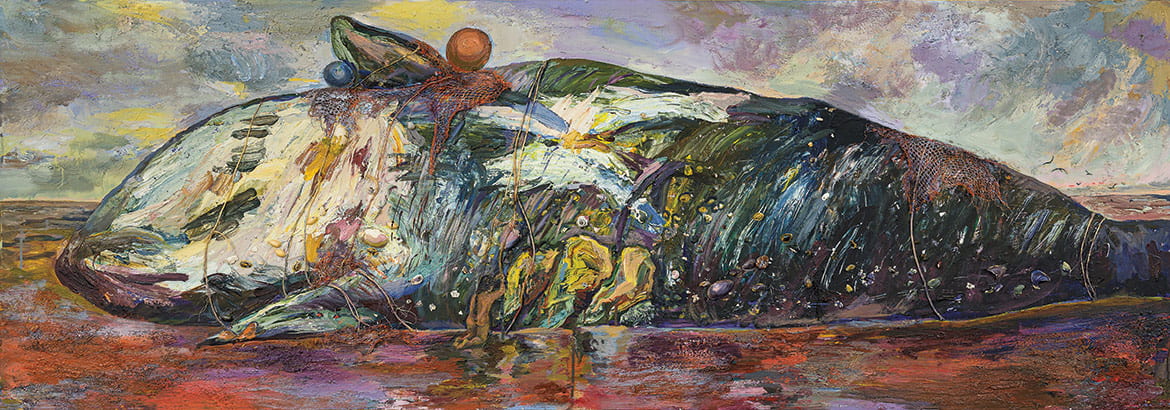
With a North Atlantic Right Whale, acrylic paint, seashells from Essex, MA, broken phone cords, twine, pistachio shells, used coffee grounds, and plastic net packaging for fruits on wood, 82 x 28” (2021). Photo by Justin Knight
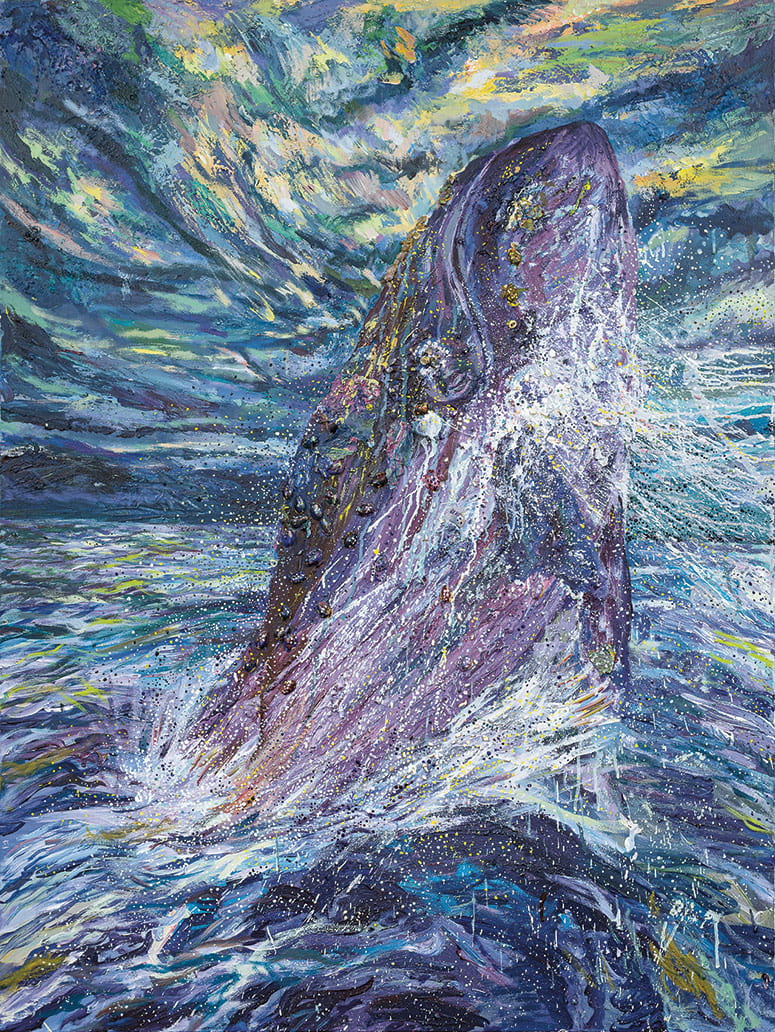
Breach, acrylic, flour, seeds, barnacles, and beads on canvas, 36 x 48” (2021). Photo by Justin Knight
You breach to kiss the sky.
Your body carries water sparkles, like a confetti explosion.
In the storm,
the sky, the ocean, and I celebrate you.
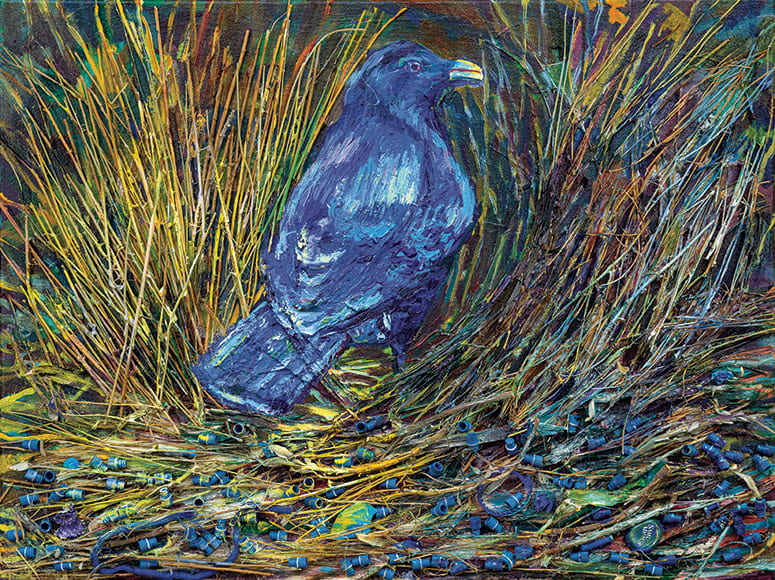
Bowerbird’s Blue Nest, blue caps from Harvard COVID testing collected by the artist and her friends, pine needles and branches from Cambridge, MA, flour, and acrylic on canvas, 18 x 24” (2022). Photo by Justin Knight
During the pandemic, every student at Harvard was required to do a weekly COVID test. One twists open a blue-capped tube and inserts the collected samples. The blue cap is then discarded. Since the beginning of the school year, I have noticed many blue caps on the ground around the Harvard campus. I imagined them floating on the ocean and getting eaten by the albatrosses or getting stuck in a turtle’s nose. I began collecting them with the help of my friends. It became a daily practice of being present as my eyes constantly searched for blue things while walking.
I learned that male satin bowerbirds from New Zealand and Australia gather only blue-colored objects to decorate their nests and attract female bowerbirds. They used to gather blue flowers and berries but they now mostly find blue straws and packaging that are discarded in the forests. I create this piece with my friends’ help to encourage us to not forget about the consequences of our actions and the current pandemic world we live in.
I would like to thank my bowerbird friends who helped me gather and save blue caps and blue trash: Emily Ostler, Sue Butler, Swati Chauhan, Morgan Curtis, Naomi Fastovsky, Mariachiara Ficarelli, Yisi Liu, Quinn Matos, Ana Laura Malmaceda, Leslie MacPherson, Jacob Mortimer, Dan Wells, Ven. Mahayaye Vineetha, and Qi Yi.
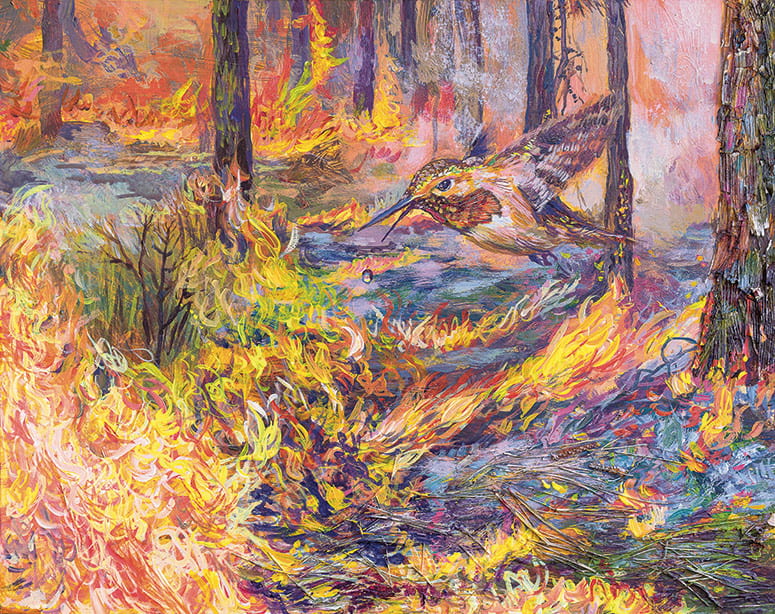
Lessons from a Hummingbird, acrylic, pine needles, and corn husks on wood, 14 x 11” (2021). Photo by Justin Knight
I asked you what I can do when climate change is worsening.
You tell me a story. “One time, there was a huge fire in the forest.
All the animals fled. As they watched their home burn, they felt helpless and overwhelmed. But there came a tiny hummingbird who decided to find the nearest water and began bringing a drop of water with its beak at a time. The hummingbird just knew that it couldn’t waste any time. It went back and forth and as fast as it could. The big animals told the hummingbird that there was no use because the fire was too big. The bird told them, “I will do the best I can.”
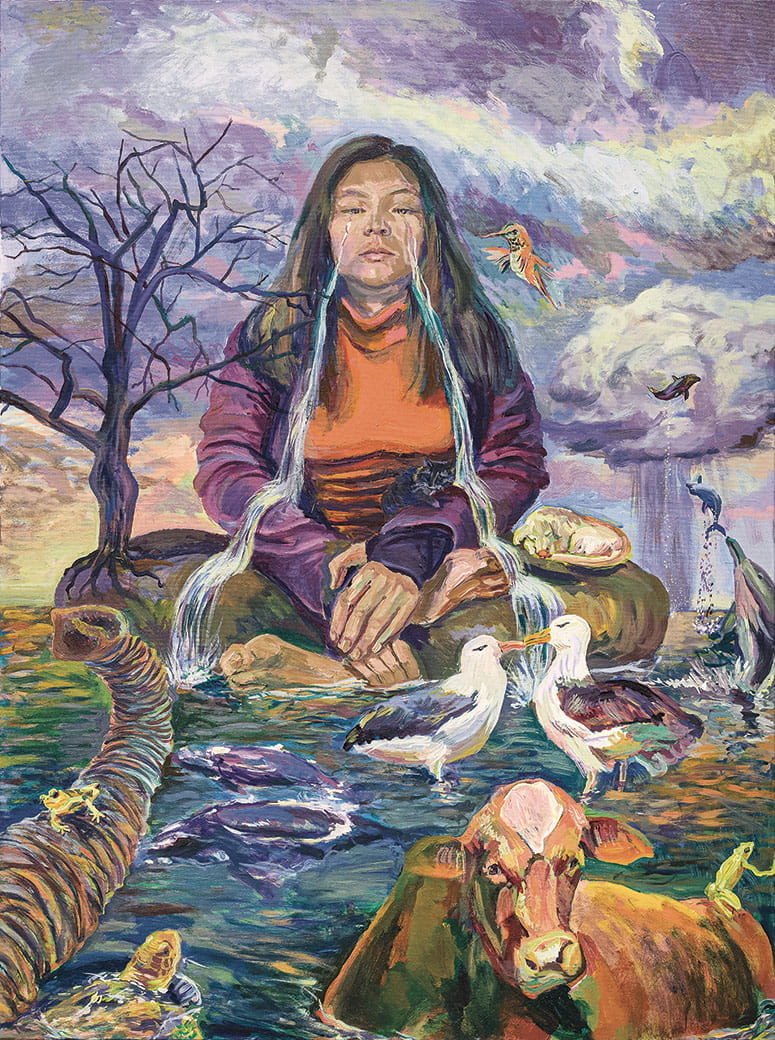
Rivers of Tears, acrylic on canvas, 36 x 48” (2022). Photo by Justin Knight
In Rivers of Tears (2022), I meditate on my love for the animals whom I have formed a relationship with through painting this year. The work is inspired by my experience doing a Chenrezig compassion meditation with my Animal Ethics classmates and Janet Gyatso in the fall. We sat on golden and red leaves as the sun began to set. Professor Gyatso asked us to visualize and send light from our hearts to the beings who are suffering in the world. Many animals and people who were suffering came to my mind. I felt deep grief and love at the same time.
Maisie Luo, MTS ’22, is currently pursuing a master of fine arts degree at Rutgers University, NJ. Her work invites the audience to reexamine their relationship with animals and the environment. Please visit www.maisieluo.com to view her other works.
Please follow our Commentary Guidelines when engaging in discussion on this site.


You are truly using your gifts correctly. I wish everyone would. Thank you for doing your part in our world. Blessings to you.
Dear Maisie,
This is wonderful work! I remember seeing it in the gallery at Harvard, and loving it then. I am glad it is up on the web so more people can see it.
The whale is in the gallery now. I saw it today. I was delighted to see it today! A happy surprise!
Thank you for your wonderful work!
Sue Butler